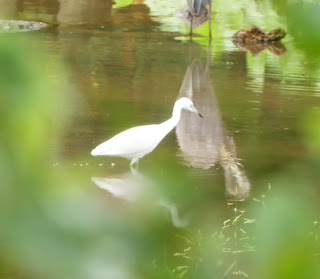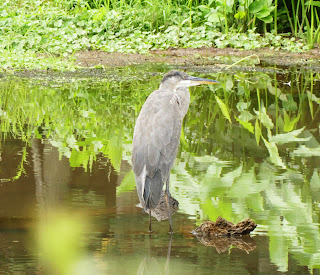Both Blue Herons
For Throwback Thursday, here's a bird I rarely encounter along with a bird I frequently encounter. The 1st 2 pictures are of a Little Blue Heron while the last picture is of a Great Blue Heron.
Notice how dark all over the Little Blue Heron is, with its purple-maroon head and slaty-blue body. Wait, that's not what you're seeing? Sorry, that was a description of an adult Little Blue Heron; juveniles start out looking all white, and could be confused with a smallish Great Egret. In fact, the main reason I didn't make that mistake was because I had heard that a Little Blue Heron had been sighted here, so I was halfway to the right ID before I even saw it.
Having said that, there are differences between Great Egrets and juvenile Little Blue Herons:
- Size: Normally I'd hesitate to even mention this since judging size from a distance can be error-prone. But in this case (see below) there was a Great Blue Heron standing nearby to use as a reference.
- Bill: The bill of the Great Egret should be almost entirely yellow. In this individual, the beak starts as a very light gray with quite a bit of black near the tip.
- Legs: The legs of the Great Egret should be basically black. In the 2nd picture you can see a little of the heron's right leg, and it's certainly not black.
As I've mentioned before, you shouldn't get too hung up about differentiating herons and egrets since all egrets are herons. Furthermore, despite the Little Blue Heron having a name so similar to the Great Blue Heron, the Great Blue Heron is much more closely related to the Great Egret than to the Little Blue Heron.
 | |
| August 27, 2019 at Duke Farms Photo 50288032, (c) jpviolette, some rights reserved (CC BY-NC) |
 |
| August 27, 2019 at Duke Farms Photo 50288037, (c) jpviolette, some rights reserved (CC BY-NC) |
In the 1st picture you might have noticed a reflection in the water of another bird; it was this Great Blue Heron. Since I usually see Great Blue Herons alone I suspect they prefer not to forage around similar wading birds. Although the Great Blue Heron may not have liked having another bird (especially a juvenile that probably makes mistakes like being too loud or moving too fast), but AFAIK it tolerated its smaller cousin.
 |
| August 27, 2019 at Duke Farms Photo 50288014, (c) jpviolette, some rights reserved (CC BY-NC) |



Comments
Post a Comment